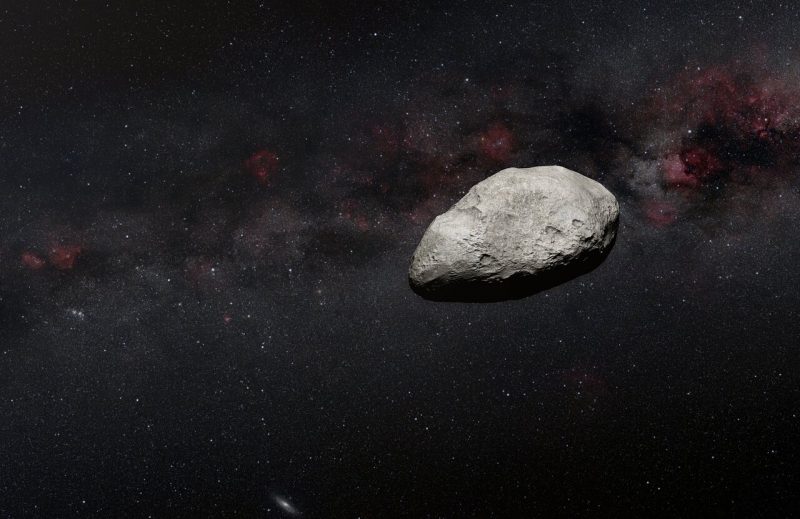
Webb’s smallest main-belt asteroid
The Webb Space Telescope launched a little over a year ago, and finished its optical alignment and calibration phase last summer. And now astronomers are busy seeing what the Webb can do. European astronomers said, on February 6, 2023, that Webb had detected a previously unknown, very small main-belt asteroid, its smallest yet. The asteroid is only about 300 to 650 feet (100 to 200-meters) across. That’s in contrast to hundreds of miles across for the biggest asteroids. But the little asteroid is making big news in the world of astronomy.
For one thing, the team found it by accident. They found it while looking at data from the calibration of Webb’s Mid-InfraRed Instrument (MIRI). In this process, they serendipitously noticed an interloper asteroid, that is, an asteroid they didn’t expect to see. Astronomers currently know of more than 1.1 million asteroids, born in the early days of the solar system. The team said it’s happy, partly because the new discovery shows Webb will let astronomers explore these objects further, leading to groundbreaking new science. But also, their statement said, Webb seems to have:
… an unpredicted aptitude for serendipitously detecting small and previously unknown objects.
Thomas Müller, an astronomer at the Max Planck Institute for Extraterrestrial Physics in Germany, said:
We – completely unexpectedly – detected a small asteroid in publicly available MIRI calibration observations. The measurements are some of the first MIRI measurements targeting the ecliptic plane. And our work suggests that many new objects will be detected with this instrument.
Here’s what they learned
So these astronomers weren’t hunting for asteroids. Instead, they were puzzling over Webb images of a known asteroid, the main-belt asteroid (10920) 1998 BC1, discovered in 1998.
Looking at the images of asteroid 10920, the team at first thought something was wrong. The images looked as if they weren’t calibrated correctly, and they thought the problem might be:
… the brightness of the target and an offset telescope pointing. Despite this, the team used the data on asteroid 10920 to establish and test a new technique to constrain an object’s orbit and to estimate its size. The validity of the method was demonstrated for asteroid 10920 using the MIRI observations combined with data from ground-based telescopes and ESA’s Gaia mission.
In the course of testing this new method with asteroid 10920, the team found the small and previously unknown interloper asteroid. The team’s results suggested the new asteroid’s size of 100–200 meters (330-660 feet). Plus they learned it occupies a very low-inclination orbit (it doesn’t have much tilt with respect to the plane of the orbits of Earth and other major planets around our sun). And they found it was located in the inner main-belt region, at least at the time of the Webb observations.
Müller said:
Our results show that even ‘failed’ Webb observations can be scientifically useful, if you have the right mindset and a little bit of luck. Our detection lies in the main asteroid belt, but Webb’s incredible sensitivity made it possible to see this roughly 100-meter object at a distance of more than 100 million kilometers [60 million miles].
How small is the asteroid?
As you might imagine, the million known asteroids in our solar system come in all sizes. The biggest one – Ceres – is nearly 1,000 kilometers across (583.7 miles / 939.4 km). It’s big enough to have enough self-gravity to be in the shape of a ball. And it’s big enough that, in 2006, astronomers categorized it as a dwarf planet.
But computer models predict that very small asteroids can also exist. Obviously, astronomers can’t study them as easily; they can’t see them as well, even with super sophisticated telescopes like Webb. So the newly found small asteroid has, as these astronomers said:
… important implications for our understanding of the formation and evolution of the solar system. Future dedicated Webb observations will allow astronomers to study asteroids smaller than 1 kilometer [0.6 miles] in size, providing the necessary data to refine our models of the solar system’s formation.
What’s more, this result suggests that Webb will also be able to serendipitously contribute to the detection of new asteroids. The team suspect that even short MIRI observations close to the plane of the solar system will always include a few asteroids, most of which will be unknown objects.
Bryan Holler, Webb support scientist at the Space Telescope Science Institute in Baltimore, Maryland, said:
This is a fantastic result which highlights the capabilities of MIRI to serendipitously detect a previously undetectable size of asteroid in the main belt. Repeats of these observations are in the process of being scheduled, and we are fully expecting new asteroid interlopers in those images!
Bottom line: The Webb space telescope has detected a new 300-650 feet (100–200-meter) asteroid. It’s roughly the size of Rome’s Colosseum and is Webb’s smallest main-belt asteroid yet.











